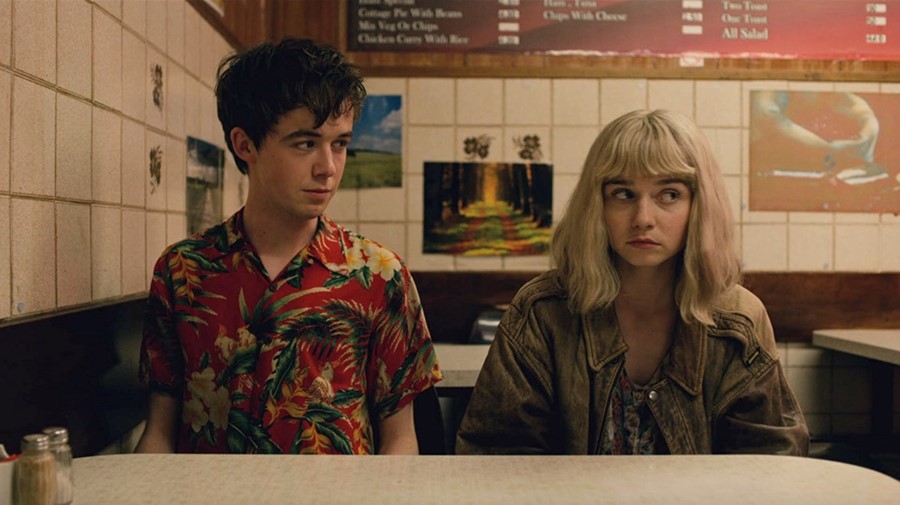Katie Livingston
Staff Writer
The End of the F***ing World is a counterculture style show that uses its place in the genre to critique counterculture values.
Where most films with quintessentially “deep” and “quirky” teen protagonists tend to devalue emotional vulnerability and relationships, The End of the F***ing World hails them as the disillusioned teen’s only salvation.
Popular media romanticizes teenagers to the point of absurdity, depicting idealized versions of their lives, their looks, and their emotional and sexual relationships.
The genre of teen fiction that appeals to the masses is decidedly fake, unrealistic, and unattainable.
In response to this depiction of teens in popular media, another genre of teen media has emerged: a counterculture version.
Shows and movies in this genre usually depict angsty social outcasts who are fed up with the system.
The teens in these films bond over their mutual hatred for society and their shared sense of intellectual superiority. There is an underlying assumption that they are better than the airheads around them, simply because they don’t chase frivolity in the same way.
This genre of teen fiction to values cynicism and devalues emotions as a sign of weakness.
Because of how James and Alyssa, the two main characters of The End of the F***ing World, are depicted in the first few episodes, the viewer gets the sense that they represent these counter culture values, and that the show will largely follow the formula of counterculture media before it.
In actuality, however, the show effectively denounces both ideologies. It mocks the ideal of perfect teen relationships through its normalized depictions of sex and violence.
More importantly, however, it goes against the values of other counterculture films by presenting James and Alyssa’s traits as negative, rather than a sign that they’re superior.
What the show values instead is candidacy, emotional vulnerability and genuine connection with another human being.
When the viewer is introduced to the two main characters, they are stoic, emotionally detached and critical of the society in which they live.
Alyssa shows a clear disdain for her mother, who has bought into the cookie cutter suburbanite lifestyle and covets the life of her father, who left her long ago. Alyssa excuses him for his neglect because he “didn’t fit in” and she “doesn’t trust people who fit in.”
She hides her pent up rage under the facade of not caring, calling things that clearly affect her “bull s***t.”
The world doesn’t care about Alyssa, so she has to convince herself that she doesn’t care about the world.
James is the opposite. Where Alyssa is characterized by her rage and vengefulness, James is characterized by his lack of emotion.
Alyssa cares too much, and seeks to convince herself that she doesn’t care, while James feels nothing and seeks out ways to feel something.
Because of his emotional numbness, James thinks he is a psychopath. As a child, he killed several small animals and stuck his left hand in a deep fryer, leaving himself permanently scarred. This was in an attempt to elect an emotional response out of himself, all to no avail.
Like Alyssa, James shows a disdain for the authority of his parents and for the system, calling school beneath him. He’s only there, he says, to find his next target.
He intends to kill a person, hopping that will finally help him feel something.
When James and Alyssa originally attach themselves to one another it’s in order to use one another.
Alyssa, deprived of attention and often ignored, is looking for someone who will give her attention and break up the monotony of her life.
Jame is simply looking for someone to kill.
Their respective dysfunctions make them a perfect match.
When Alyssa finally comes to a breaking point in her life, she suggests that they run away together. Seeing this as his opportunity to kill Alyssa, James agrees.
Their road trip goes wrong and gets dark rather quickly.
James and Alyssa soon realize they’re in over their heads, with Alyssa noting that once you step outside the bounds of society, the world becomes a scary place.
Viewers are soon exposed to the stark reality that James and Alyssa’s character traits that make them endearing and “different” are actually character flaws, a result of the pain and trauma in their lives.
Alyssa’s devil-may-care attitude gets the two into trouble on several occasions, especially when her demands for James to take off his shirt while driving end in a car accident that leaves them both stranded.
James’ inability to connect with his emotions makes him a dangerously passive character, willing to go along with anything that he’s told.
This passivity allows for Alyssa’s volatile behavior to be magnified and get them into more trouble than necessary.
Their freedom does not free them from the bondage of society, but accentuates their vices, making them slaves to their own ill adjusted coping mechanisms.
It is their growing relationship with one another, however, that slowly begins to pull them from these dynamics.
As the story progresses Alyssa shifts from being controlling of James to listening to him. She stops running and starts trusting someone fully.
James, in turn, learns to start feeling again.
They discover that the ways in which they were dealing with their problems were not effective.
James didn’t need to kill someone, he needed to deal with the trauma from his past that caused him to close off emotionally, and to open himself up to feeling for someone again.
Alyssa didn’t need the exhilaration of freedom, or to reconcile with her estranged father. She needed to stop seeking the approval of people who didn’t care about her, and to open herself up to caring about someone who did.
The End of the F***ing World closes with James saying “I think I finally understand what people mean to each other.”
This line exemplifies the underlying theme of the show.

